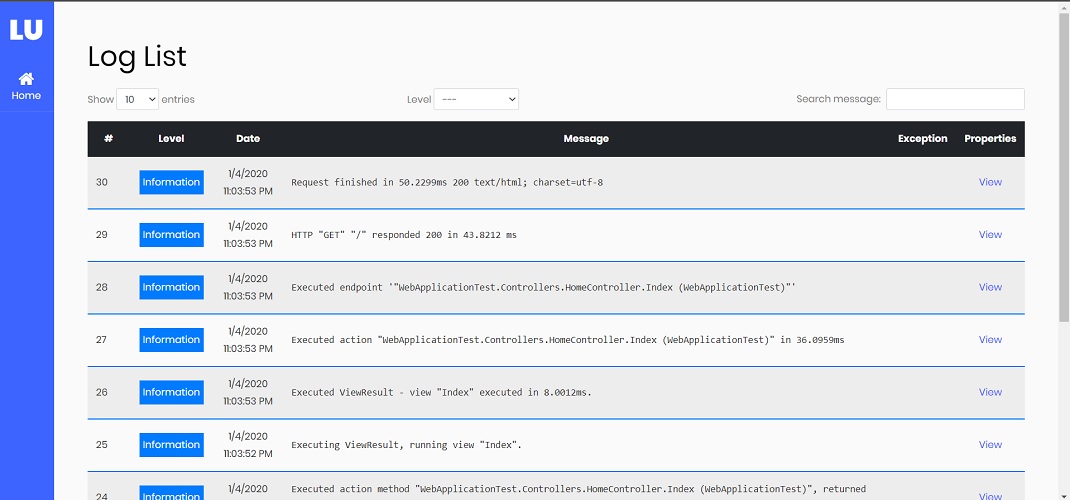Error Message: Serilog.Ui.MongoDbProvider.MongoDbLogModel: Ambiguous discriminator 'SqlException'.
{"_id":{"$oid":"61a8dadd1ab0e48d55b06626"},"Level":"Error","UtcTimeStamp":{"$date":"2021-12-02T14:40:30.436Z"},"MessageTemplate":{"Text":"An exception occurred while iterating over the results of a query for context type '{contextType}'.{newline}{error}","Tokens":[{"_t":"TextToken","StartIndex":0,"Text":"An exception occurred while iterating over the results of a query for context type '"},{"_t":"PropertyToken","StartIndex":84},{"_t":"TextToken","StartIndex":97,"Text":"'."},{"_t":"PropertyToken","StartIndex":99},{"_t":"PropertyToken","StartIndex":108}]},"RenderedMessage":"An exception occurred while iterating over the results of a query for context type '\"AcerPlatformV2.Infrastructure.LoggerDbContext\"'.\"\r\n\"\"Microsoft.Data.SqlClient.SqlException (0x80131904): Invalid object name 'SystemControlLogs'.\r\n at Microsoft.Data.SqlClient.SqlConnection.OnError(SqlException exception, Boolean breakConnection, Action`1 wrapCloseInAction)\r\n at Microsoft.Data.SqlClient.SqlInternalConnection.OnError(SqlException exception, Boolean breakConnection, Action`1 wrapCloseInAction)\r\n at Microsoft.Data.SqlClient.TdsParser.ThrowExceptionAndWarning(TdsParserStateObject stateObj, Boolean callerHasConnectionLock, Boolean asyncClose)\r\n at Microsoft.Data.SqlClient.TdsParser.TryRun(RunBehavior runBehavior, SqlCommand cmdHandler, SqlDataReader dataStream, BulkCopySimpleResultSet bulkCopyHandler, TdsParserStateObject stateObj, Boolean& dataReady)\r\n at Microsoft.Data.SqlClient.SqlDataReader.TryConsumeMetaData()\r\n at Microsoft.Data.SqlClient.SqlDataReader.get_MetaData()\r\n at Microsoft.Data.SqlClient.SqlCommand.FinishExecuteReader(SqlDataReader ds, RunBehavior runBehavior, String resetOptionsString, Boolean isInternal, Boolean forDescribeParameterEncryption, Boolean shouldCacheForAlwaysEncrypted)\r\n at Microsoft.Data.SqlClient.SqlCommand.RunExecuteReaderTds(CommandBehavior cmdBehavior, RunBehavior runBehavior, Boolean returnStream, Boolean isAsync, Int32 timeout, Task& task, Boolean asyncWrite, Boolean inRetry, SqlDataReader ds, Boolean describeParameterEncryptionRequest)\r\n at Microsoft.Data.SqlClient.SqlCommand.RunExecuteReader(CommandBehavior cmdBehavior, RunBehavior runBehavior, Boolean returnStream, TaskCompletionSource`1 completion, Int32 timeout, Task& task, Boolean& usedCache, Boolean asyncWrite, Boolean inRetry, String method)\r\n at Microsoft.Data.SqlClient.SqlCommand.RunExecuteReader(CommandBehavior cmdBehavior, RunBehavior runBehavior, Boolean returnStream, String method)\r\n at Microsoft.Data.SqlClient.SqlCommand.ExecuteReader(CommandBehavior behavior)\r\n at Microsoft.Data.SqlClient.SqlCommand.ExecuteDbDataReader(CommandBehavior behavior)\r\n at System.Data.Common.DbCommand.ExecuteReader()\r\n at Microsoft.EntityFrameworkCore.Storage.RelationalCommand.ExecuteReader(RelationalCommandParameterObject parameterObject)\r\n at Microsoft.EntityFrameworkCore.Query.Internal.SingleQueryingEnumerable`1.Enumerator.InitializeReader(DbContext _, Boolean result)\r\n at Microsoft.EntityFrameworkCore.SqlServer.Storage.Internal.SqlServerExecutionStrategy.Execute[TState,TResult](TState state, Func`3 operation, Func`3 verifySucceeded)\r\n at Microsoft.EntityFrameworkCore.Query.Internal.SingleQueryingEnumerable`1.Enumerator.MoveNext()\r\nClientConnectionId:47fb5428-dd6e-4ff3-a4d4-03d1960792a9\r\nError Number:208,State:1,Class:16\"","Properties":{"contextType":"AcerPlatformV2.Infrastructure.LoggerDbContext","newline":"\r\n","error":"Microsoft.Data.SqlClient.SqlException (0x80131904): Invalid object name 'SystemControlLogs'.\r\n at Microsoft.Data.SqlClient.SqlConnection.OnError(SqlException exception, Boolean breakConnection, Action`1 wrapCloseInAction)\r\n at Microsoft.Data.SqlClient.SqlInternalConnection.OnError(SqlException exception, Boolean breakConnection, Action`1 wrapCloseInAction)\r\n at Microsoft.Data.SqlClient.TdsParser.ThrowExceptionAndWarning(TdsParserStateObject stateObj, Boolean callerHasConnectionLock, Boolean asyncClose)\r\n at Microsoft.Data.SqlClient.TdsParser.TryRun(RunBehavior runBehavior, SqlCommand cmdHandler, SqlDataReader dataStream, BulkCopySimpleResultSet bulkCopyHandler, TdsParserStateObject stateObj, Boolean& dataReady)\r\n at Microsoft.Data.SqlClient.SqlDataReader.TryConsumeMetaData()\r\n at Microsoft.Data.SqlClient.SqlDataReader.get_MetaData()\r\n at Microsoft.Data.SqlClient.SqlCommand.FinishExecuteReader(SqlDataReader ds, RunBehavior runBehavior, String resetOptionsString, Boolean isInternal, Boolean forDescribeParameterEncryption, Boolean shouldCacheForAlwaysEncrypted)\r\n at Microsoft.Data.SqlClient.SqlCommand.RunExecuteReaderTds(CommandBehavior cmdBehavior, RunBehavior runBehavior, Boolean returnStream, Boolean isAsync, Int32 timeout, Task& task, Boolean asyncWrite, Boolean inRetry, SqlDataReader ds, Boolean describeParameterEncryptionRequest)\r\n at Microsoft.Data.SqlClient.SqlCommand.RunExecuteReader(CommandBehavior cmdBehavior, RunBehavior runBehavior, Boolean returnStream, TaskCompletionSource`1 completion, Int32 timeout, Task& task, Boolean& usedCache, Boolean asyncWrite, Boolean inRetry, String method)\r\n at Microsoft.Data.SqlClient.SqlCommand.RunExecuteReader(CommandBehavior cmdBehavior, RunBehavior runBehavior, Boolean returnStream, String method)\r\n at Microsoft.Data.SqlClient.SqlCommand.ExecuteReader(CommandBehavior behavior)\r\n at Microsoft.Data.SqlClient.SqlCommand.ExecuteDbDataReader(CommandBehavior behavior)\r\n at System.Data.Common.DbCommand.ExecuteReader()\r\n at Microsoft.EntityFrameworkCore.Storage.RelationalCommand.ExecuteReader(RelationalCommandParameterObject parameterObject)\r\n at Microsoft.EntityFrameworkCore.Query.Internal.SingleQueryingEnumerable`1.Enumerator.InitializeReader(DbContext _, Boolean result)\r\n at Microsoft.EntityFrameworkCore.SqlServer.Storage.Internal.SqlServerExecutionStrategy.Execute[TState,TResult](TState state, Func`3 operation, Func`3 verifySucceeded)\r\n at Microsoft.EntityFrameworkCore.Query.Internal.SingleQueryingEnumerable`1.Enumerator.MoveNext()\r\nClientConnectionId:47fb5428-dd6e-4ff3-a4d4-03d1960792a9\r\nError Number:208,State:1,Class:16","EventId":{"Id":10100,"Name":"Microsoft.EntityFrameworkCore.Query.QueryIterationFailed"},"SourceContext":"Microsoft.EntityFrameworkCore.Query"},"Exception":{"_t":"SqlException","HelpLink":null,"Source":"Core Microsoft SqlClient Data Provider","HResult":-2146232060,"Message":"Invalid object name 'SystemControlLogs'.","StackTrace":" at Microsoft.Data.SqlClient.SqlConnection.OnError(SqlException exception, Boolean breakConnection, Action`1 wrapCloseInAction)\r\n at Microsoft.Data.SqlClient.SqlInternalConnection.OnError(SqlException exception, Boolean breakConnection, Action`1 wrapCloseInAction)\r\n at Microsoft.Data.SqlClient.TdsParser.ThrowExceptionAndWarning(TdsParserStateObject stateObj, Boolean callerHasConnectionLock, Boolean asyncClose)\r\n at Microsoft.Data.SqlClient.TdsParser.TryRun(RunBehavior runBehavior, SqlCommand cmdHandler, SqlDataReader dataStream, BulkCopySimpleResultSet bulkCopyHandler, TdsParserStateObject stateObj, Boolean& dataReady)\r\n at Microsoft.Data.SqlClient.SqlDataReader.TryConsumeMetaData()\r\n at Microsoft.Data.SqlClient.SqlDataReader.get_MetaData()\r\n at Microsoft.Data.SqlClient.SqlCommand.FinishExecuteReader(SqlDataReader ds, RunBehavior runBehavior, String resetOptionsString, Boolean isInternal, Boolean forDescribeParameterEncryption, Boolean shouldCacheForAlwaysEncrypted)\r\n at Microsoft.Data.SqlClient.SqlCommand.RunExecuteReaderTds(CommandBehavior cmdBehavior, RunBehavior runBehavior, Boolean returnStream, Boolean isAsync, Int32 timeout, Task& task, Boolean asyncWrite, Boolean inRetry, SqlDataReader ds, Boolean describeParameterEncryptionRequest)\r\n at Microsoft.Data.SqlClient.SqlCommand.RunExecuteReader(CommandBehavior cmdBehavior, RunBehavior runBehavior, Boolean returnStream, TaskCompletionSource`1 completion, Int32 timeout, Task& task, Boolean& usedCache, Boolean asyncWrite, Boolean inRetry, String method)\r\n at Microsoft.Data.SqlClient.SqlCommand.RunExecuteReader(CommandBehavior cmdBehavior, RunBehavior runBehavior, Boolean returnStream, String method)\r\n at Microsoft.Data.SqlClient.SqlCommand.ExecuteReader(CommandBehavior behavior)\r\n at Microsoft.Data.SqlClient.SqlCommand.ExecuteDbDataReader(CommandBehavior behavior)\r\n at System.Data.Common.DbCommand.ExecuteReader()\r\n at Microsoft.EntityFrameworkCore.Storage.RelationalCommand.ExecuteReader(RelationalCommandParameterObject parameterObject)\r\n at Microsoft.EntityFrameworkCore.Query.Internal.SingleQueryingEnumerable`1.Enumerator.InitializeReader(DbContext _, Boolean result)\r\n at Microsoft.EntityFrameworkCore.SqlServer.Storage.Internal.SqlServerExecutionStrategy.Execute[TState,TResult](TState state, Func`3 operation, Func`3 verifySucceeded)\r\n at Microsoft.EntityFrameworkCore.Query.Internal.SingleQueryingEnumerable`1.Enumerator.MoveNext()\r\n at System.Collections.Generic.List`1..ctor(IEnumerable`1 collection)\r\n at System.Linq.Enumerable.ToList[TSource](IEnumerable`1 source)\r\n at AcerPlatformV2.Business.Services.SystemControlLogService.GetLastLogs(Int32 logCount) in D:\\MT\\Projects\\GatewayProUI.git\\AcerPlatformV2.Business\\Services\\SystemControlLogService.cs:line 108\r\n at AcerPlatformV2.Presentation.ModelServices.MonitoringModelService.SystemControlErrorLogNotification() in D:\\MT\\Projects\\GatewayProUI.git\\AcerPlatformV2.Presentation\\ModelServices\\MonitoringModelService.cs:line 112\r\n at System.Runtime.CompilerServices.TaskAwaiter.GetResult()","Data":{"HelpLink-ProdName":"Microsoft SQL Server","HelpLink-ProdVer":"13.00.4001","HelpLink-EvtSrc":"MSSQLServer","HelpLink-EvtID":"208","HelpLink-BaseHelpUrl":"http://go.microsoft.com/fwlink","HelpLink-LinkId":"20476"}}}




























